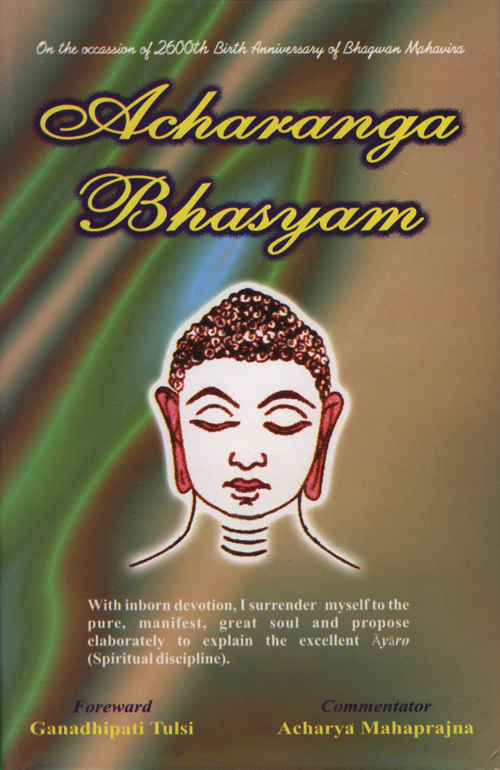The Ācārāṅga has been described in details in Samavāyāṅga and the Nandῑ. According to them, the main studies of the Ācārāṅga are 'Ācāra gocara' i.e. code of conduct, vinaya (humility), vaināyika (fruition of humility), sthāna (difference postures), gamana (travelling), cankramaṇa (movements), bhojana-mātra (quantity of food intake), svādhyāya (spiritual studies), bhāṣā samiti (principles of speech), gupti (restraint or of mind, speech and body), sayyā (place of stay), upādhῑ (belongings) etc. The Ācārāṅga recommends purity of all these aspects.[1] Acharya Umāsvati has briefly dealt with the subject matter of the nine chapters of the Ācārāṅga. They are: [2]
- Ṣaḍjῑvanikāya yatanā - self-restraint in respect of the six kinds of living beings.
- Abandoning of ego over worldly things.
- Conquest over trials and tribulations of life.
- Unshakable perception about righteousness.
- Detachment towards worldly affairs.
- The process to decay or destroy the karmas.
- Service towards elders.
- Penance and austerities.
- Renunciation of attachment to sexual objects.
The Niryuktikāra mentions about following themes that were the subject of studies of navabrahmacarya. They are:
- Abandonment of violence towards living beings.
- Conquest over passions.
- Equanimity about happiness and suffering.
- Right perception.
- Abandonment of matters that are hindrance to salvation and acceptance of right knowledge/perception/character.
- Feeling of detachment.
- Ability to endure sufferings.
- Practice to attain Nirvana.
- Practice of code of conduct practised by Lord Mahāvῑra. [3]
According to Acharya Akalanka, the comprehensive theme of the Ācārāṅga is the code of conduct of an ascetic,[4] and according to Aprajita Suri, it deals with the practice of three gems - right perception, right knowledge and right conduct.[5]
In Jaina Tradition, the term Ācāra has been used in very wide sense. Ācāra has been described in different aspects:[6]
- Jñānācāra
- Darśanācāra
- Cāritrācāra
- Tapācāra
- Vῑryācāra
In this Āgama, all the five Ācāras have been dealt with.
Philosophical Value
The Ācārāṅga is a very important Āgama considering its philosophical value. Acharya Siddhasena has enumerated six eternal truths contained in the Jaina philosophy.[7] They are:
- Soul exists.
- It is eternal.
- It is the subject of action (it is the doer).
- It reaps its fruits.
- There is nirvāṇa - emancipation.
- There is path to attain emancipation.
All the six truths mentioned above have been dealt with in great details in the Ācārāṅga, and, therefore, it is considered to be the foundation on which the Jaina philosophy has been raised. The first truth is - Soul exists. The Ācārāṅga begins with the explanation of this very truth.[8] There is also the mention of immortality of soul together with this.[9] 'O man! Thou art thy own friend'.[10 ]'You yourself the maker of thorn'.[11] These sentences are pointing towards the soul's exertion.[12] There is the reference to 'co-feeling'.[13] This is showing the reaction undergoing the fruition of the action. The nirvāṇa said to be 'uniquely supreme'. As all adjuncts cease there, there is nothing more supreme than it. At various places, there is explanation of right view, right knowledge and right conduct as the means to attain nirvāṇa.
Faith and Independent Thinking
The Ācārāṅga is the ocean of faith, 'saḍḍhῑ aṇāe mehāvῑ’,[14] 'āṇāe mamagaṃ dhammaṃ'[15] and many other expressions of similar nature reflect faith in total devotion to one's own venerable. The Ācārāṅga does not rule out freedom of the devotee to dedicate his faith on any object for realization of truth. The Ācārāṅga prescribes three means:
(i) Sahasammatti (ii) Paravyākaraṇa (iii) Śrutānuśruta.[16] The first is - svasmṛti - to realize truth through one's own search. 'Maimam pāsa'[17] - this dictum facilitates freedom of thoughts. The Vṛttikāra has paraphrased it on - "It is not only for me to say. You can also see it." Thus, the Ācārāṅga has very subtly synthesised independence of approach and faith, which is the proper way to seek truth. Either of them are not sufficient enough to work alone for realization of truth.
Touchstone
The Ācārāṅga, being the oldest sūtra, is like a touchstone for the later sūtras. The Ācāra i.e. code of conduct prescribed by it is the foundation for all further development. It is the nearest to what Lord Mahāvῑra persuade in his own life. The later versions have tried to develop the basic ideas given in the Ācārāṅga. Ācāracūlā is an example of this process of development and evolution of basic tenets prescribed in the Ācārāṅga, although we find a few new concepts here and there. It seems that the later acharyas, when they established the doctrine like utsarga i.e. universal rules of conduct and apavāda i.e. special rules of conduct and amendment in the universal rules, they certified certain rules of conduct in their various attempts. Ācāracūlā is the first such attempt.
Contemporary Thinking
There is mention of other lines of thinking like Vaidika, Aupaniṣadika and Bauddha in the Ācārāṅga such as 'whether one wishes to go to a forest for realization [18] of the self or the eternal truth', 'whether the gospel of Dharma can be freely dispersed to all high or low',[19] 'are there layers like castes in any society', etc. Lord Mahāvῑra has given his candid opinion on such questions as reflected in the Ācārāṅga. So it is neither high nor low (intrinsically). One should not therefore covet status.[20] It is, therefore, very valuable and original source for comparative study of the Vedic, Buddhist and other faiths.
jiasaṃjamo a logo jaha bajjhai jaha ya taṃ pajahiyavvaṃ.
suhasukkhatitikkhāviya sammattaṃ logasāro ya..
nisaaṃgayā ya cchaṭṭhe mohasamutthā parῑsahuvasaggā.
nijjāṇaṃaṭṭhamae navame ya jiṇeṇa evaṃti..
atthi avinasa-dhammi, karei veei atthi nivvanam.
atthi ya mokkhovao, cha sammattassathanairn..
 Acharya Mahaprajna
Acharya Mahaprajna

